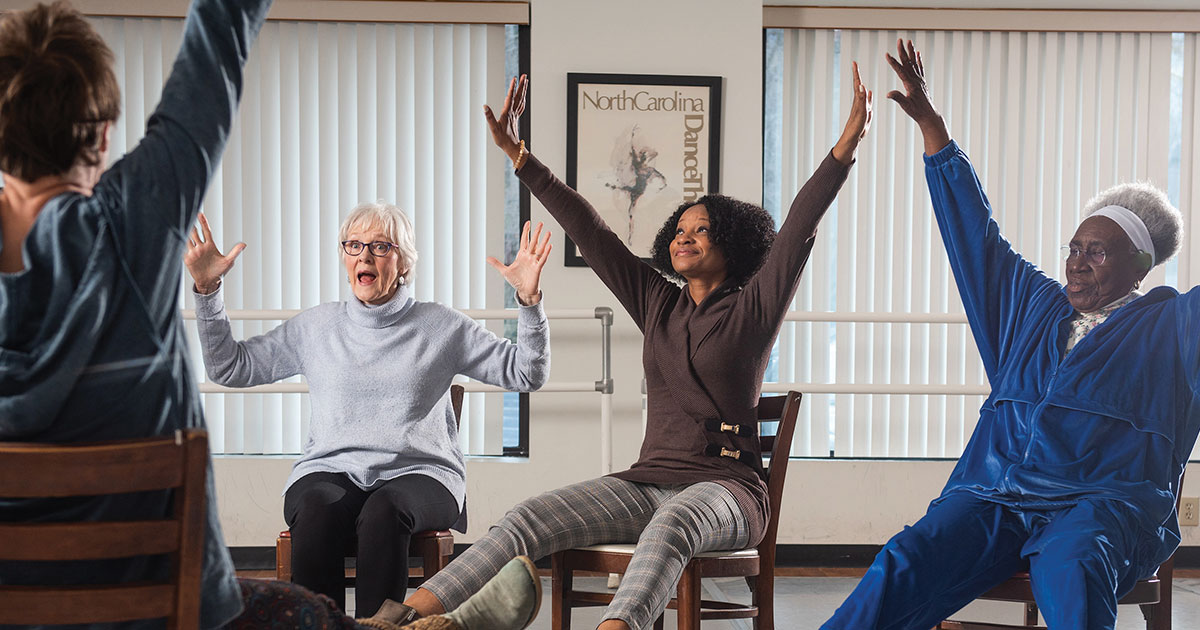BY CHRISTINA E. HUGENSCHMIDT, PHD
The health benefits of dance have been getting a lot of press lately.
In an article earlier this year, The New York Times referred to dance as the “kale of exercise” for the anti-aging benefits that research shows dance could provide. A 2003 study showed that dance was the only leisure-time physical activity associated with lower risk for dementia, and subsequent small trials have suggested that dance improves brain health.
Dance is particularly intriguing in the context of aging because it combines art with physical, cognitive, and social activity, all of which have known benefits for the aging body and brain.
Winston-Salem has its own clinical trial, funded through the National Institutes of Health, that is focused on the effects of dance, making it a great fit for the “City of Arts and Innovation.” The IMOVE study at Wake Forest Baptist Health is examining how dance affects the brains and bodies of older adults experiencing early stages of memory loss.
Many people don’t realize it, but changes in walking and balance often accompany memory loss. Studies show that people with memory loss are more likely to fall than others their same age who do not have memory loss, and falls are a main reason people with memory loss visit the emergency room. Memory loss is also linked with decreased social engagement. Dance might be a way to help with both movement and social engagement at the same time.
The pilot study for IMOVE showed that, in people with early-stage memory loss, participating in dance movement twice a week for eight weeks improved balance, mood and functional connections in the brain in regions that are important for motor movement and social engagement.
The pilot study was small, though, and these effects might not be the same across a larger group of people. Also, it didn’t answer important questions about why the dance movement was helpful. Did the movement increase brain connectivity, or did it increase the social interactions, or was it important to have movement and social contact together? The current larger study will answer these questions.
The IMOVE study is unique in several ways. First, it uses improvisational movement. That doesn’t mean people wear all black or twirl ribbons. Improvisational movement is a modern dance form that uses open-ended movement cues rather than planned choreography.
This method has been honed by dancer and choreographer Christina Soriano for people of all ages and abilities in a method she calls IMPROVment®. Soriano is director of dance and associate provost for the arts and interdisciplinary programs at Wake Forest University. Using her IMPROVment approach, dancers can work to their own level of challenge safely, even while remaining seated. It also creates a fun, playful atmosphere because there is no “right” way to do any movement.
Because the movements change rapidly, it is cognitively challenging. At the same time, movements don’t have to be remembered from exercise to exercise or class to class. Another unique aspect of the IMOVE study is that people with memory concerns come with a partner, like a spouse, friend, or family member, creating an opportunity to spend time together.
For the IMOVE study to succeed, it needs one thing: participants. The study needs people who are between 60 and 85 years old who have a diagnosed memory loss. They must have a family member, caregiver, or study partner who will participate with them, attending classes twice a week for 12 weeks.
Study participants can move as much or as little as they both are able to, and can attend classes in either Greensboro or Winston-Salem.
To join the IMOVE study or to learn more, contact the IMOVE study team at 336-713-MOVE (713-6683) or visit wakehealth.edu/beinvolved/IMOVE. More information about the IMPROVment method is online at improvment.us.
Christina E. Hugenschmidt, PhD, is associate professor of Gerontology and Geriatric Medicine at Wake Forest Baptist Health and is leading the IMOVE study.





















